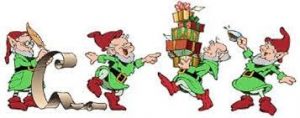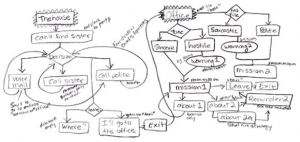
RMU has established a tool kit that balances out race, class and creature creation by assigning DP values to skills, abilities and attributes. It’s very detailed and typical RM! A currently running thread on the RM Forums is about Race balance, and more specifically Elves.
We discussed Elves here on the RolemasterBlog, and it’s also a common topic on RPG blogs as well. It seems like people either love or hate em! However, if you look through the various games or popular fiction, Elves can vary quite a bit, differentiated from the foundational trope established by Tolkien.
For purposes of this blog, Elves can be measured on the “Fey Scale”, with 1 being basically human with some unique physical differences and 10 being truly unearthly or alien. Let’s take a look at a variety of products and how they treat Elves.
D&D.
Per Wiki: Elves are renowned for their grace and mastery of magic and weapons such as the sword and bow. Becoming physically mature by the age of 25 and emotionally mature at around 125,[1] they are also famously long-lived, capable of living more than half a millennium and remaining physically youthful. Possessed of innate beauty and easy gracefulness, they are viewed as both wondrous and haughty by other races; however, their natural detachment is seen by some as introversion or xenophobia.
Gary Gygax claims Dungeons & Dragons elves draw very little from Tolkien.[5] Elves in Dungeons & Dragons are immune to paralysis as a holdover from a game balance adjustment in Chainmail.[6]
Reviewing some of the earlier D&D products I think Elfs started with the intent of being more Fey, but they feel more anthropomorphized in later editions.
Fey Scale 2-4
Richard Morgan’s “The Steel Remains”.
Elves in this great book series are called “Dwenda” and the race Aldrain.
The Aldrain are a race of immortal humans. They are often referred to as the Vanishing Folk or dwenda. They reside primarily in The Ageless Realm. They are described as being beautiful, with bone-white colored skin, gaunt, bone-sharp features, and dark black colored eyes, and do not like the sunlight. They can move impossibly fast and strong, and carry weapons and armor with featureless, sleek helms. They have their own language simply referred to as the Aldrain tongue.
The Aldrain can control strong, magic-like powers. When they appear and travel to Earth, they are engulfed in a flickering blue fire. A black, crystalline rock called glirsht can be used as beacons to guide the Aldrain to Earth from The Ageless Realm.
The Aldrain are referred to by a wide variety of names:
- dwenda
- Vanishing Folk
- Witch Folk
- Eldar Race
- Shining Immortal Ones
When introduced in the story, the Dwenda are formidable, using powerful combat magic and seem virtually undefeatable.
Fey Scale 9-10
Steven Erickson. The Malazan Series.
In this sprawling series, the Elves are called “Tiste” and are divided into three distinct races:
Each Elvish type have distinct physical features—triggered by their choice of patron diety. While very long lived, the Tiste are powerful, but not much different than other races. Their motivations, emotions and personalities are very human.
Fey Scale 2-3
Tad Williams. The Dragonbone Chair
But long before Mankind peopled Osten Ard, it is said that the undying Gardenborn once ruled these lands, building nine great cities long before humans walked the lands. Old stories say that the Sithi, Norns, Dwarrows, and Niskies were driven away when Mankind grew powerful centuries ago.
The Sithi
Chief among the Gardenborn clans were the Sithi, whom the people of Hernystir called “the peaceful ones”. It was the Hernystiri who gave these immortal folk the name “Sithi”. The Sithi called themselves Zida’ya, meaning Children of the Dawn. They once dwelled in the fair cities of Da’ai Chikiza, Enki e-Shayosaye, Kementari, and Tumet’ai. But their greatest stronghold was at Asu’a, the city which looked eastward, toward their lost homeland.
Despite the medieval European setting, the Sithi are Asian-influenced in their names and clothing. They also are quite different physically from humans, to the point of having recognizably different bone structure.
Fey Scale: 9-10
So what about Shadow World? Terry has given us several branches of Elves: the rustic Erlin (Wood Elves), and the Iylar (High Elves that are futher divided into Dyari, Loari and Linaeri).
Erlini Fey Scale 2-3
Dyari Fey Scale 3-5
Linaeri Fey Scale 7-8
Loari Fey Scale 5-7
I think the more “Fey” the Elvish type the harder it is to roleplay and perhaps harder to maintain a racial balance in a game system. Truly Fey elves are often depicted as higher beings with powers and attributes that mirror higher level powers in role playing games. How does that fit into the game world as a PC?
For more in depth info on the topic of Elves in fiction and games click HERE.








